While visiting the Festival of the Cranes at the Bosque del Apache National Wildlife Refuge, I naturally peeked in to the visitors center and the little shop operated by the Friends of the Bosque located there. Experience has taught me that very often these little refuge shops can be excellent locations to discover some very interesting books addressing the natural history of the local area – and indeed, this was the case here. While there were literally dozens of books seen on the shelves that were worthy of note, those that follow particularly caught my attention.
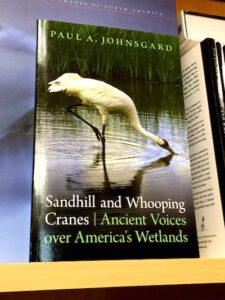 Sandhill and Whooping Cranes; Ancient Voices over America’s Wetlands by Paul A. Johnsgard from the University of Nebraska Press combines just the right amount of the natural history of these two highly charismatic species with just a touch of poetic reflection on their place in the environment all in a relatively short and highly readable book. For those coming to the area for the first time this book should be considered mandatory reading, for it is very difficult indeed to imagine anyone visiting the Bosque without either having already read this book or making the effort to read it during their visit there.
Sandhill and Whooping Cranes; Ancient Voices over America’s Wetlands by Paul A. Johnsgard from the University of Nebraska Press combines just the right amount of the natural history of these two highly charismatic species with just a touch of poetic reflection on their place in the environment all in a relatively short and highly readable book. For those coming to the area for the first time this book should be considered mandatory reading, for it is very difficult indeed to imagine anyone visiting the Bosque without either having already read this book or making the effort to read it during their visit there.
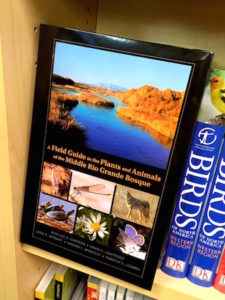 A Field Guide to the Plants and Animals of the Middle Rio Grande Bosque by Jean-Luc E. Cartron, Timothy Lowrey, Jane Mygatt, Sandra Brantley, and David Lightfoot from the University of New Mexico Press provides a fascinating overview of the flora and fauna of the area. While the book is a very useful resource for those living in the region, it is absolutely essential for all general naturalists visiting it if a solid understanding of what is to be seen there is to be understood (I know many times I found myself looking at a plant along the trail, a lizard skittering across it, or an insect flying past and wishing I had a guide ready-at-hand that could tell me what it was.)
A Field Guide to the Plants and Animals of the Middle Rio Grande Bosque by Jean-Luc E. Cartron, Timothy Lowrey, Jane Mygatt, Sandra Brantley, and David Lightfoot from the University of New Mexico Press provides a fascinating overview of the flora and fauna of the area. While the book is a very useful resource for those living in the region, it is absolutely essential for all general naturalists visiting it if a solid understanding of what is to be seen there is to be understood (I know many times I found myself looking at a plant along the trail, a lizard skittering across it, or an insect flying past and wishing I had a guide ready-at-hand that could tell me what it was.)
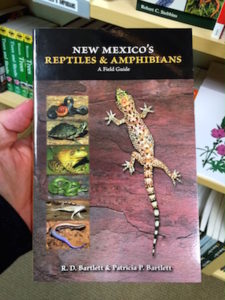 And speaking of lizards, as New Mexico is home to 165 species and subspecies of snakes, lizards, turtles, frogs, toads, and salamanders, having a reference book ready at hand – particularly for those like me who reside in regions where such creatures are far less common – is what my wife likes to call a “no brainer.” Therefore New Mexico’s Reptiles and Amphibians: A Field Guide by R. D. Bartlett and Patricia P. Bartlett, another of the University of New Mexico Press’ field guides, is a book that the visiting naturalist would do well to have in his or her field bag.
And speaking of lizards, as New Mexico is home to 165 species and subspecies of snakes, lizards, turtles, frogs, toads, and salamanders, having a reference book ready at hand – particularly for those like me who reside in regions where such creatures are far less common – is what my wife likes to call a “no brainer.” Therefore New Mexico’s Reptiles and Amphibians: A Field Guide by R. D. Bartlett and Patricia P. Bartlett, another of the University of New Mexico Press’ field guides, is a book that the visiting naturalist would do well to have in his or her field bag.
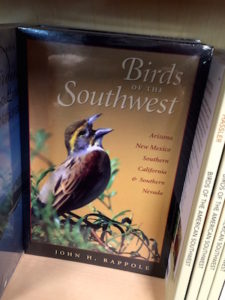 While it admittedly covers a larger area than merely the Bosque, Birds of the Southwest; A Field Guide by John H. Rappole from Texas A&M University Press’ W. L. Moody Jr. Natural History Series is a highly recommended book for bird watchers and naturalists interested in the avifauna to be found in the Bosque del Apache National Wildlife Reserve. Not only does it include the relevant information for more than 450 species of birds known to inhabit its designated region, it also includes information about more than 400 “hot spots” in which particular species are likely to be seen.
While it admittedly covers a larger area than merely the Bosque, Birds of the Southwest; A Field Guide by John H. Rappole from Texas A&M University Press’ W. L. Moody Jr. Natural History Series is a highly recommended book for bird watchers and naturalists interested in the avifauna to be found in the Bosque del Apache National Wildlife Reserve. Not only does it include the relevant information for more than 450 species of birds known to inhabit its designated region, it also includes information about more than 400 “hot spots” in which particular species are likely to be seen.
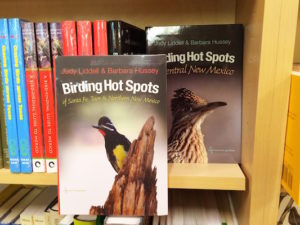 Of course if it’s New Mexico’s birding hot spots your looking for, two other volumes included in Texas A&M University Press’ W. L. Moody Jr. Natural History Series will lead you right to them. Birding Hot Spots of Central New Mexico and Birding Hot Spots of Santa Fe, Taos, and Northern New Mexico by Judy Liddell and Barbara Hussey will provide all the information needed to find those special bird watching places that generally only the locals know.
Of course if it’s New Mexico’s birding hot spots your looking for, two other volumes included in Texas A&M University Press’ W. L. Moody Jr. Natural History Series will lead you right to them. Birding Hot Spots of Central New Mexico and Birding Hot Spots of Santa Fe, Taos, and Northern New Mexico by Judy Liddell and Barbara Hussey will provide all the information needed to find those special bird watching places that generally only the locals know.
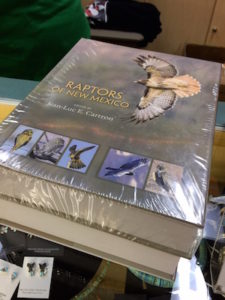 Unfortunately for this on-site survey of books, the volunteer from Friends of the Bosque who had just unpacked a new shipment of Raptors of New Mexico for the shop had failed to unwrap an examination copy – or, perhaps due to the large number of small children scurrying about the premises that day, wisely refrained from doing so with such a large and impressive-looking book. Thus all I know of this University of New Mexico Press published book is that it is a compilation of the work of various authorities on the species and edited by Jean-Luc E. Cartron. Even so, I just couldn’t leave it out as it looked so tantalizing. Perhaps I’ll come across a copy I can peruse at some later date.
Unfortunately for this on-site survey of books, the volunteer from Friends of the Bosque who had just unpacked a new shipment of Raptors of New Mexico for the shop had failed to unwrap an examination copy – or, perhaps due to the large number of small children scurrying about the premises that day, wisely refrained from doing so with such a large and impressive-looking book. Thus all I know of this University of New Mexico Press published book is that it is a compilation of the work of various authorities on the species and edited by Jean-Luc E. Cartron. Even so, I just couldn’t leave it out as it looked so tantalizing. Perhaps I’ll come across a copy I can peruse at some later date.
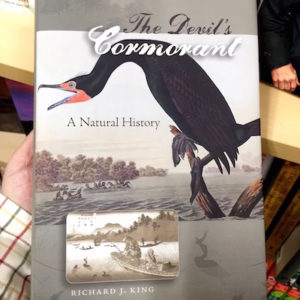 And finally, although not a book addressing either the Bosque itself or a species particularly associated with it, out of gratitude for the shop’s stocking and thus bringing it to my attention, I must make mention of The Devil’s Cormorant; a Natural History by Richard King. Bearing the imprint of the University of New Hampshire Press and, as a bit if inquiry disclosed, distributed by the University Press of New England, this is not a book of which I had previously been aware. Published around the same time as two other noteworthy books on cormorants that I did read – and in one case reviewed – The Devil’s Cormorant looks to be quite an interesting work in and of itself, and I have added it my list of books to be sure to someday read.
And finally, although not a book addressing either the Bosque itself or a species particularly associated with it, out of gratitude for the shop’s stocking and thus bringing it to my attention, I must make mention of The Devil’s Cormorant; a Natural History by Richard King. Bearing the imprint of the University of New Hampshire Press and, as a bit if inquiry disclosed, distributed by the University Press of New England, this is not a book of which I had previously been aware. Published around the same time as two other noteworthy books on cormorants that I did read – and in one case reviewed – The Devil’s Cormorant looks to be quite an interesting work in and of itself, and I have added it my list of books to be sure to someday read.
